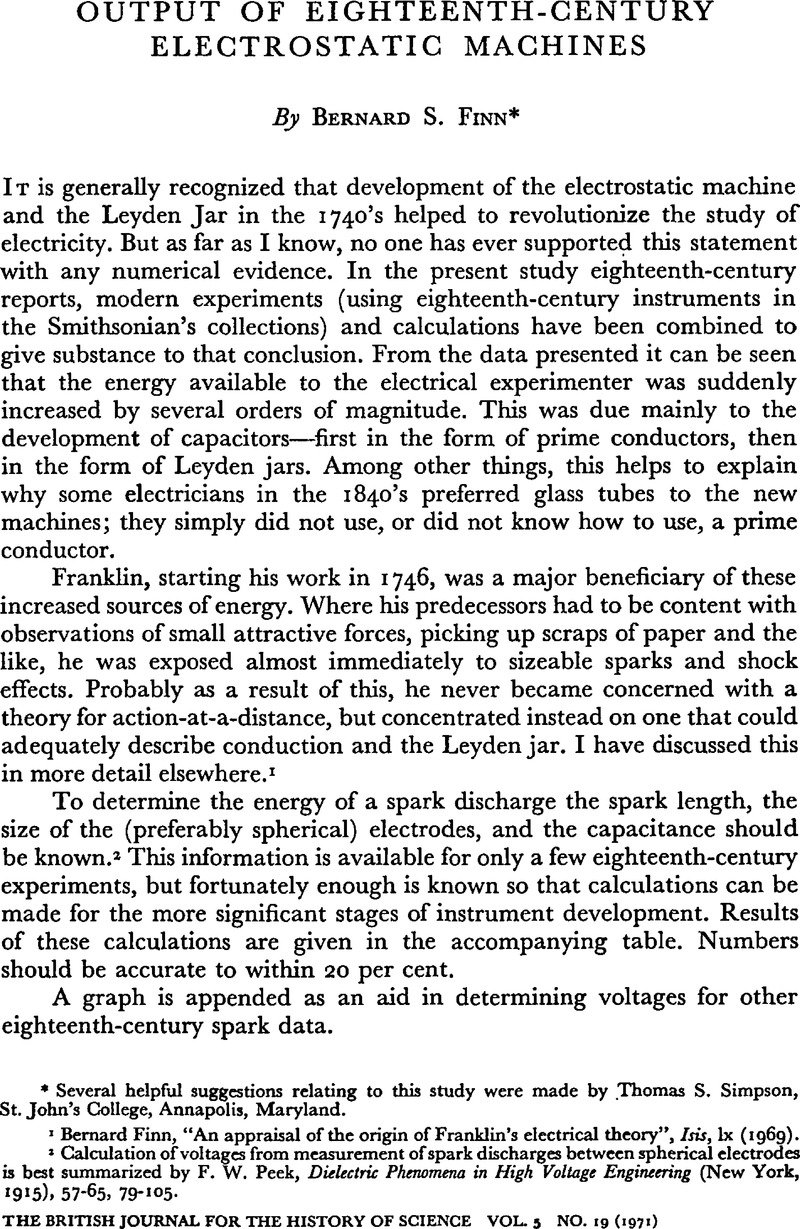Article contents
Output of Eighteenth-Century Electrostatic Machines
Published online by Cambridge University Press: 05 January 2009
Abstract

- Type
- Notes and Documents
- Information
- Copyright
- Copyright © British Society for the History of Science 1971
References
1 Finn, Bernard, “An appraisal of the origin of Franklin's electrical theory”, Isis, lx (1969).Google Scholar
2 Calculation of voltages from measurement of spark discharges between spherical electrodes is best summarized by Peek, F. W., Dielectric Phenomena in High Voltage Engineering (New York, 1915), 57–65, 79–105.Google Scholar
3 B. Franklin, Letter to Collinson, Peter, 25 05 1747Google Scholar, in Papers of Benjamin Franklin (New Haven, Yale: 1959-), iii, 127.Google Scholar He charged a piece of iron shot three to four inches in diameter and drew sparks from it with a “blunt body”. It has been assumed here that the blunt body had the same diameter as the shot; if its effective diameter was one inch, with the shot four inches, the voltage should be increased to about 100,000. It is not certain, but the context of the letter indicates that a tube was used. Capacitance measurements made on glass tubes vary considerably with the condition (conductivity) of the glass surface; the value listed is a high estimate.
4 B. Franklin, Letter to Collinson, Peter, 29 07 1750, Papers, iv, 17–18.Google Scholar The spark was taken from a cylindrical prime conductor one foot in diameter. When drawn off by his knuckle, the spark was about two inches long; when a one-inch thick iron punch, round and smooth at the end, was used, the spark was also two inches (replaced by three inches in printed editions). The gun-barrel capacitance is a measured value. The prime conductor on the Franklin machine now at the Franklin Institute in Philadelphia is 13·5 inches in diameter; its capacitance has been calculated. The Leyden jar value is a rough average of those measured for the various early jars in the Smithsonian collections; the extremes of these measurements did not differ from the average by more than 50 per cent.
5 B. Franklin, Letter to Priestley, , 4 05 1772Google Scholar, in Schofield, R. E., A Scientific Autobiography of Joseph Priestley (Cambridge, Mass., M.I.T. Press, 1966), 101.Google Scholar The prime conductor was four feet long and about four inches in diameter. The size of the other electrode has been assumed at one inch. Capacitance was measured for a similar prime conductor in the Smithsonian's collections.
6 Nairne, Edward, “Electrical Experiments”, Phil. Trans., lxiv (1774), 79.CrossRefGoogle Scholar The spark was apparently taken from a knob on the prime conductor 1¼ inches in diameter to another ball two inches in diameter. Since 14 inches is well beyond a reasonable extrapolation of the appropriate curve, I have estimated the voltage from data on another Nairne machine reported in William Nicholson, Introduction to Natural Philosophy, 2nd edn. (London, 1790), ii, 306. That machine produced nine-inch sparks between a prime conductor about four inches in diameter by one foot and a ball 2½ inches in diameter, or about 170,000 volts. Nairne reported using a battery of 64 jars in 1773; they are arbitrarily considered as similar to those in the Smithsonian collections.
7 van Marum, Martinus, Description d'une très grande machine électrique, i (Haarlem, 1785), 28.Google Scholar The spark is also drawn to scale in an accompanying picture. Capacitance of the prime conductor is estimated. Capacitance of the Leyden jars is calculated from dimensions measured on one of the original jars. The 100-jar battery was put into service in 1790 and is described by van Marum in vol. iii (1795), 194 ff. In 1785 he had used a battery of 135 smaller jars, described in vol. i, 154 ff., with a total capacity that can be estimated (if the glass thickness was the same as that of the later jars) at about 130 μf.
8 These curves apply only for identical electrodes. For unequal electrodes it is a fair approximation to consider the larger sphere replaced by one equal in diameter to the smaller sphere. The length of the spark should then be increased by R−r−(R2 − r2)/s, where R and r are radii of the larger and smaller spheres and s is the distance between their centres.
- 3
- Cited by


